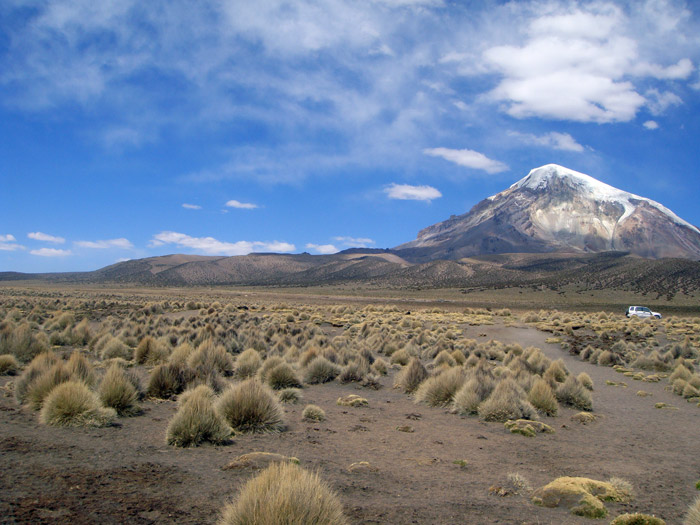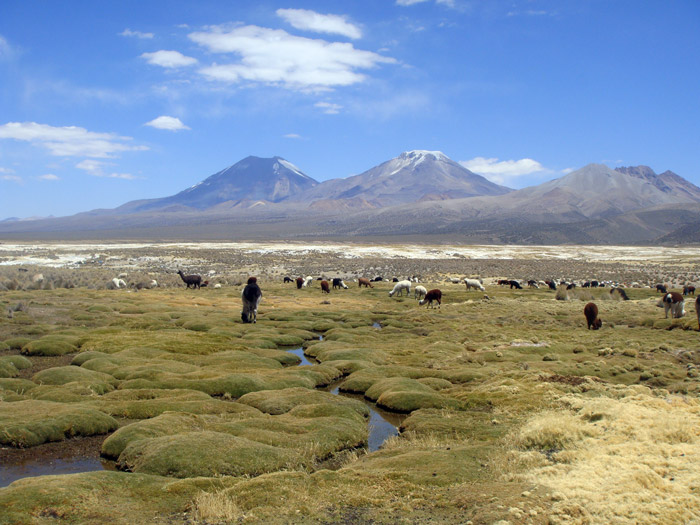Four hours drive from La Paz towards Chile you have the Sajama National Park (4100m), with the second highest volcano in the world; Sajama (6542m), and as a side-effect thereof; hot springs.
We left at 7am and even so, there was quite a lot of traffic coming in and out of La Paz and El Alto. People here drive like they have 9 lives, yet they don’t. So you gotta be careful and if you don’t use your horn like a frantic, people wont think you are there. But once we turned south toward the Chilean border, traffic disappeared almost totally.
From the rather dull landscape of the high plateau, the environment now changed dramatically. Cliffs started to rise and fall, and colors of red and yellow started to dominate the landscape. It then changed to a scenery where you would expect to see Indians and cowboys behind every little outcrop of rock or ridge. Cylinder like rock formations followed and by now we could see several volcanoes on the horizon.
After about 3 hours drive, on an increasingly more interesting road, we turned right, into the Sajama national park itself. With four wheel drive on, we now headed straight for the Sajama volcano that would continue to rise. Little snow was to be seen on the gletscher, which is strange since we had just come out of the winter season.
After passing through the little village also named after the volcano; Sajama. A very worn out yet beautiful church stood there, like it had been abandoned years ago.
On we went to the Huayna Khota Laguna, which was totally dried out. Only an almost unreckonisable cadaver was to be seen. Later though on our way back, we would see a herd of Vicunas, browsing through the dried out laguna.
At a dent in the road we turned right down towards the hot springs. It could be seen from a distance by the fog of water rising above its source. The silence of the place was like being in the desert, on the close horizon a few twisters of dust rose to the sky without a sound. All around us we had llamas grazing along the zigzagging springs of water and ponds.
At one point I went to touch the water of one such pond, to check if it was warm, only to set my hand hard into a very spiky grass like growth. Pain and cold water followed. We had to go closer to the source, to get to the hot springs.
At the source itself, there was a few buildings, where the local families were living. The families share the income they can make from people like us, coming to the springs to bathe. Each family has it for one week, and then another family takes over the place.
The tranquillity, the light was amazing, the view towards the Sajama vulcano breathtaking, changing colors from deep red, orange to complete white. Somewhat like the ground we were standing on. All over the place you could see minerals coming up from the water beneath, resulting in small flats of salt here and there.
A little pool of hot water was there, no more than ten by three meters, but with a very comfortable temperature. The further up the enclosing stream you went, the warmer the water got, until it would be almost burning. The smell of sulfur rose from the surface. Amazing to lie there at the root of the second highest volcano on the planet, being warmed by its interior, at the depth of the mountain.
I must return to this place with a mountain bike and a tent. Cant think of a better place to hang out for a few days.
We reached La Paz at around 6pm on the same day.
See more pictures here.
See Topas Travel for more info.
Thomas Sindberg



